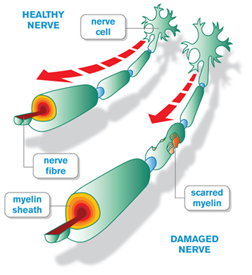What is MS
 Multiple Sclerosis (MS) is a disorder of the central nervous system (CNS) which includes the brain, spinal cord and optic nerves.
Multiple Sclerosis (MS) is a disorder of the central nervous system (CNS) which includes the brain, spinal cord and optic nerves.
The CNS is responsible for our conscious and unconscious functioning, including movement and the response to sensations such as sight, touch and hearing. It directs these functions by sending its instructions in the form of electrical impulses to the appropriate sites along nerve fibres.
Nerve fibres are coated in a protective insulating covering called the myelin sheath—this serves a very similar function to the coating around electrical wires. Myelin is important in speeding electrical conduction along nerve fibres and in insulating nerve fibres from one another.
The term multiple sclerosis refers to multiple areas of scarring (sclerosis) scattered throughout the brain and spinal cord. These scars are the result of patches of inflammation that are the basic cause of damage to nerve fibres and of the suddenly appearing symptoms that are referred to as an attack, exacerbation or relapse.
Patches of inflammation sometimes heal spontaneously over several weeks or months when symptoms may resolve completely or residual impairment may result if they do not.
The inflammation causes damage particularly to the insulating myelin sheath covering nerve fibres, and may also damage the nerve fibres (axons) themselves.
In MS, the typical damage is often referred to as “demyelination”. The nature of the symptoms and their severity depends partly on the site of the patch of inflammation (or lesion) and partly on its nature and intensity.
The course of MS varies widely from person to person. Some people will only ever experience mild symptoms over their lifetime while others will have relapses followed by incomplete remission when disability may worsen in a stepwise fashion with each relapse experienced. A number of people experience slowly progressive, worsening of disability over many months or years. There is uncertainty how much of this progressive process is due to low-grade inflammation and how much to loss of previously damaged nerve fibres.
Thanks to the Multiple Sclerosis Society of New Zealand for this content. For further and more in-depth information please go to their website www.msnz.org.nz
Who gets MS in New Zealand
Using data from the MSNZ funded MS Prevalence Study (2006) and MS Incidence Study (2012-14) it is estimated that about one New Zealander in every thousand has MS. Thus, there are just over 4000 people in New Zealand diagnosed with MS.
It is more common in:
Young adults – symptoms usually appear between the ages of 20 and 50 with a peak in the early 30’s. Currently in New Zealand the average age is 37 years old.
Women – women are affected approximately three times more often than men.
Caucasians – MS is more prevalent in Caucasians (people with ancestry from Northern Europe), than any other racial group. It is rarely found in Maori and Polynesian people and is uncommon in Asian people.
The prevalence in New Zealand is approximately 1 per 1,000 with the annual incidence being around 134 people per year.
People in cooler climates – generally MS becomes more common the further away from the equator you are. Thus the prevalence of MS is much higher in regions such as the South Island of NZ, Scotland and Canada than it is in tropical and sub-tropical areas.
Near relatives – those with a close relative with MS have an slight increased risk. Having a first-degree relative, (mother, father, sibling) with MS increases the chances of having it from approximately 1 in every 1,000 people to 30 in every 1,000. But it is important to note that the great majority of people with an affected first-degree relative do not develop MS.
MS is not contagious or infectious; it is not possible to contract it from close contact with a person with MS.
